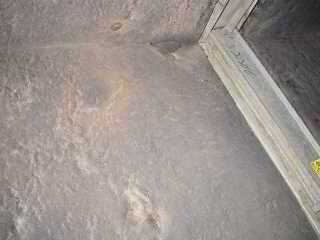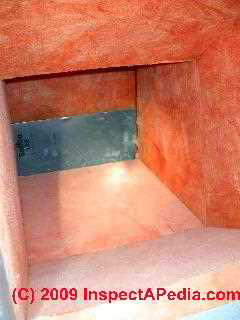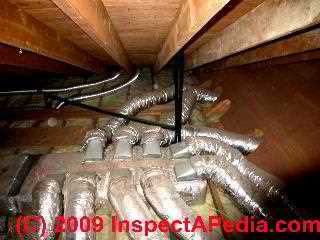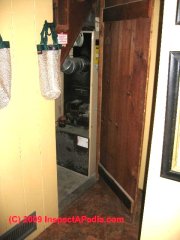 Guide to HVAC Duct Sound Control in buildings
Guide to HVAC Duct Sound Control in buildings
- POST a QUESTION or COMMENT about sound or noise transmission through HVAC ductwork
Noise & sound control for air conditioning or heating system ductwork:
This article explains methods and materials used to control heating, ventilation, and cooling duct noises and sound transmission in buildings: how to make a quiet home, office, or place of business using sound isolation for ceilings, floors, walls, plumbing, etc.
InspectAPedia tolerates no conflicts of interest. We have no relationship with advertisers, products, or services discussed at this website.
- Daniel Friedman, Publisher/Editor/Author - See WHO ARE WE?
HVAC Duct Insulation Options for Soundproofing & Noise Reduction in buildings

Our page top photo shows a typical fiberglass lined HVAC duct interior. The gray debris stuck to the fiberglass is usually house dust, comprised chiefly of skin cells and fabric fiber. Sometimes more troublesome debris collects on interior HVAC duct insulation.
Our building sound control articles begin at SOUND CONTROL in buildings. Other noise and sound diagnosis and control articles are found at NOISE / SOUND DIAGNOSIS & CURE.
As stated in Best Practices Guide to Residential Construction (Steve Bliss, J Wiley & Sons) :
Use fiberglass ductboard or fiberglass duct liners to quiet the noises of fans and moving air. Avoid sharing a common duct between two rooms that need sound privacy.
Elaborating on some duct insulation considerations: HVAC experts advise us that conventional practice is to insulate the interior of metal ductwork in order to minimize transmission of HVAC equipment sounds throughout a building.
Some fiberglass duct liners are plastic coated and may be able to be cleaned using gentle procedures.
But most common is the use of un-faced fiberglass duct interior insulation, typically treated with a surface resin binder to help reduce movement of fiberglass particles into the air stream.
Our fiberglass lined duct insulation photo (left) shows clean new metal ductwork with a pink fiberglass mat sound and temperature insulation installed on the duct interior.
Our page top photo shows that building dust and debris quickly adheres to fiberglass interior duct insulation.

However our work on indoor environmental and air quality topics suggests that from an indoor air quality maintenance view, we prefer to see insulation on the exterior of metal ducts.
That approach permits the ducts to be cleaned, and it reduces the chances of mold growth in the ductwork.
See DUCT SYSTEMS and see HIDDEN MOLD in OTHER PLACES for more about places to look for duct system defects and hidden mold on HVAC systems.
Mold in Fiberglass Insulation illustrates problem mold growth in fiberglass insulation including in duct systems.
Construction of HVAC ducts from foil-faced insulating board (photo above left) combines sound and temperature insulation with aluminum foil to product ductwork that is quiet and cleanable using gentle methods.
Other steps to reduce HVAC system duct noise in buildings include:
- Proper HVAC duct mounting and routing to avoid tight contact with floor framing without use of sound isolating mounts
- Selection of the proper air handler blower size and speed
- Location of the air handler unit away from occupied space; if constructing a sound-isolated framed-in enclosure for an air handler for heating systems that burn fuel (LP gas, natural gas, oil, wood) be sure that your soundproofing does not prevent provision of safe and adequate combustion air.
An outdoor combustion air supply can permit near total isolation of HVAC equipment from the rest of the building.
Our photo (left) shows a furnace mounted in a mobile home closet. Owners, in an attempt to reduce furnace noise in the adjacent living space, closed off the return air inlet by installing a solid door. Heating output was substantially reduced and heating costs increased by this bad practice.
- - Adapted with permission from Best Practices Guide to Residential Construction (Steve Bliss, J Wiley & Sons) .
Other Heating or Air Conditioning Duct Noises
A loud BANG or THUD or CLUNK heard when the heating or air conditioning blower fan starts or stops is often due to inadequate return air, to overpressureizing of the supply plenum at fan start-up, or it may occur where large areas of un-supported sheet metal are used in the duct system or air supply or return plenums.
The problem may be more acute where a multiple speed or high speed blower fan is in use.
- See BANGING NOISE at AIR HANDLERS or in DUCT SYSTEMS
- Also see RETURN AIR, INCREASE at inspectapedia.com/aircond/Return-Air-Improvement.php
- and see UNDERSIZED RETURN DUCTS
For hissing and howling HVAC duct system noises see
- HISSING SOUNDS, HVAC from A/C or heat pump system
- HOWLING SOUNDS, HVAC from air conditioners, air handlers, blower fans, heat pumps, furnaces, duct systems & their motors
Continue reading about methods for sound control in buildings by using the links provided just below.
Research & Resources on HVAC Duct Air Duct Noise Generation, Noise Sources, Noise Control
- Caro, Stéphane, Yves Detandt, Julien Manera, Fred Mendonça, and Reinier Toppinga. "Validation of a New Hybrid CAA strategy and Application to the Noise Generated by a Flap in a Simplified HVAC Duct." In 15th AIAA/CEAS Aeroacoustics Conference (30th AIAA Aeroacoustics Conference), p. 3352. 2009.
- Fahy, Frank J., and Vincent Salmon. "Sound intensity." The Journal of the Acoustical Society of America 88, no. 4 (1990): 2044-2045.
- Gelin, Lawrence J. "Active noise control: a tutorial for HVAC designers." ASHRAE journal 39, no. 8 (1997): 43.
- Hansen, Colin, Scott Snyder, Xiaojun Qiu, Laura Brooks, and Danielle Moreau. Active control of noise and vibration. CRC press, 2012.
- Hong, Jeongho, James C. Akers, Ravinder Venugopal, Miin-Nan Lee, Andrew G. Sparks, Peter D. Washabaugh, and Dennis S. Bernstein. "Modeling, identification, and feedback control of noise in an acoustic duct." IEEE Transactions on Control Systems Technology 4, no. 3 (1996): 283-291.
- Jäger, Anke, Friedhelm Decker, Michael Hartmann, Moni Islam, Timo Lemke, Jörg Ocker, Volker Schwarz et al. "Numerical and Experimental Investigations of the Noise Generated by a Flap in a Simplified HVAC duct." AIAA Paper 2902 (2008): 2008.
- Jessel, M. J. M., and G. A. Mangiante. "Active sound absorbers in an air duct." Journal of sound and vibration 23, no. 3 (1972): 383-390.
Abstract:
Through field studies in large commercial buildings and reviews of building plans, we investigated the effective leakage areas (ELAs), air-leakage rates, and conduction heat gains of duct systems. Different methods for measuring air-leakage rates were also compared. ELAs of supply ducts ranged from 0.4 to 2.0 cm2 per square meter of floor area served, and from 1.0 to 4.8 cm2 per square meter of duct surface area.
On a per-unit-floor-area basis, these duct ELAs are comparable to the values measured in residences.
The corresponding values of duct leakage class were 60 to 270, much higher than the range of 3 to 12 reported by ASHRAE [ASHRAE Standard 111-1988, Practices for Measurement, Testing, Adjusting, and Balancing of Building Heating, Ventilation, Air Conditioning, and Refrigeration Systems, American Society of Heating, Refrigerating, and Air Conditioning Engineers, Atlanta, 1988] as attainable for quality duct construction and sealing practices when leakage at connections to duct-mounted equipment is not considered.
The measured air-leakage rates as a percentage of the inlet air flow rate varied from 0% to 30%, with most of the measurements falling between 10% and 20%.
Large inconsistencies among the air-leakage rates determined from different measurement procedures exemplify the need for further development and evaluation of measurement methods.
Heat gains between the outlet of the cooling coils and the supply registers caused supply air temperatures to increase, on average, by 0.6°C to 2°C.
The corresponding values of conduction effectiveness were 0.75 to 0.90; thus, heat conduction decreased the cooling capacity of the supply air exiting registers by 10% to 25%. Because these results are based on studies in only a few buildings, generalizations from these findings are premature. - Kuo, Sen M., and Dennis R. Morgan. "Active noise control: a tutorial review." Proceedings of the IEEE 87, no. 6 (1999): 943-973.
Abstract:
Active noise control (ANC) is achieved by introducing a cancelling "antinoise" wave through an appropriate array of secondary sources. These secondary sources are interconnected through an electronic system using a specific signal processing algorithm for the particular cancellation scheme.
ANC has application to a wide variety of problems in manufacturing, industrial operations, and consumer products. The emphasis of this paper is on the practical aspects of ANC systems in terms of adaptive signal processing and digital signal processing (DSP) implementation for real-world applications. In this paper, the basic adaptive algorithm for ANC is developed and analyzed based on single-channel broad-band feedforward control.
This algorithm is then modified for narrow-band feedforward and adaptive feedback control. In turn, these single-channel ANC algorithms are expanded to multiple-channel cases. Various online secondary-path modeling techniques and special adaptive algorithms, such as lattice, frequency-domain, subband, and recursive-least-squares, are also introduced. Applications of these techniques to actual problems are highlighted by several examples. - Morfey, C. L. "Sound transmission and generation in ducts with flow." Journal of Sound and Vibration 14, no. 1 (1971): 37-55.
Abstract:
Sound generation in hard-walled ducts with flow is treated theoretically. Axial standing waves are allowed for in the theoretical model, by applying an impedance boundary condition at the ends of the duct. The results show the effects of axial and swirling flow on the radiated sound power, for different types of source contained in the duct. Suggestions are also put forward for analysing the generation of sound by sources at a mean-flow discontinuity. - Parrondo, Jorge L., Joaquín Fernández, Iván García, and Eduardo Ruiz. "Noise transmission through duct divisions in air circuits, considered as three-port acoustic systems." Journal of sound and vibration 296, no. 1 (2006): 183-194.
Abstract:
An experimental study is presented on the characterization of the noise transmission properties of the duct junctions used in ventilation and air-conditioning air circuits, assumed as three-port acoustic systems with plane-wave sound propagation. The procedure requires the measurement and post-processing of the transfer functions between the control signals of three loudspeakers, one at each branch, and the sound pressure signal recorded at six positions (two-microphone technique).
The result is the scattering matrix, which contains three reflection coefficients and six transmission coefficients. Experiments were conducted on junctions of ducts with the same diameter, with three different deviation angles for the branch take-off. Besides, several different airflow conditions were imposed for each geometrical configuration.
This paper describes the methodology used and the results obtained for the cases tested, and discusses the effect of the different factors involved in the noise transmission through the duct divisions. - Petrie, A. M., and I. D. Huntley. "The acoustic output produced by a steady airflow through a corrugated duct." Journal of Sound and Vibration 70, no. 1 (1980): 1-9.
Abstract:
This paper is concerned with the noise produced when there is a steady flow of air down a duct which is internally corrugated. Thus it is of relevance to situations such as heat exchanger tube bundles, dissipation-type silencers and the open undercarriage holds of an aircraft.
Of particular interest here is a commercial application where low velocity air travelling along a flexible corrugated duct (of the configuration used on vacuum cleaners) can result in acoustic outputs at the duct outlet in the region of 140 dB. Experiments are described in which the phenomenon was investigated, and several methods of attenuation are discussed. - Rahn, Christopher D., and C. D. Rahn. Mechatronic control of distributed noise and vibration. New York, NY: Springer-Verlag, 2001.
- Strauch, Paul, and Bernard Mulgrew. "Active control of nonlinear noise processes in a linear duct." IEEE Transactions on Signal Processing 46, no. 9 (1998): 2404-2412.
- Walker, Iain S. BEST PRACTICES GUIDE FOR RESIDENTIAL HVAC RETROFITS. [PDF] No. LBNL--53592. Ernest Orlando Lawrence Berkeley National Laboratory, Berkeley, CA (US), 2003.
See the complete abstract for this article at AIR LEAKS in DUCT CONNECTIONS
...
Continue reading at HEATING SYSTEM NOISE DIAGNOSIS or select a topic from the closely-related articles below, or see the complete ARTICLE INDEX.
Or see these
Recommended Articles
- DUCT SYSTEM DESIGN SIZE & DEFECTS - home
- HEATING SYSTEM NOISE DIAGNOSIS
- SOUND CONTROL in BUILDINGS - home
- ACOUSTICAL SEALANT CHOICES
- COMPRESSOR MOTOR INSULATION
- FLANKING SOUND PATHWAY CUT-OFF
- ROOF NOISE TRANSMISSION
- SOUND ABSORPTION vs. SOUND ISOLATION
- SOUND CONTROL for AIR DUCTS, HVAC
- SOUND CONTROL for DOORS
- SOUND CONTROL for FLOORS
- SOUND CONTROL for PLUMBING
- SOUND CONTROL for WALLS
- SOUND EVENT LOG
- SOUND LEVEL MEASUREMENT, HOW TO
- SOUND & NOISE TRANSMISSION PRINCIPLES
- SOUND TRANSMISSION CLASS RATINGS
- SOUNDPROOFING MATERIAL PROPERTIES
- WHITE NOISE & SOUND CONDITIONERS
- SOUND EVENT LOG
Suggested citation for this web page
SOUND CONTROL for AIR DUCTS, HVAC at InspectApedia.com - online encyclopedia of building & environmental inspection, testing, diagnosis, repair, & problem prevention advice.
Or see this
INDEX to RELATED ARTICLES: ARTICLE I NDEX to BUILDING NOISE DIAGNOSIS
Or use the SEARCH BOX found below to Ask a Question or Search InspectApedia
Ask a Question or Search InspectApedia
Questions & answers or comments about sound or noise transmission through HVAC ductwork.
Try the search box just below, or if you prefer, post a question or comment in the Comments box below and we will respond promptly.
Search the InspectApedia website
Note: appearance of your Comment below may be delayed: if your comment contains an image, photograph, web link, or text that looks to the software as if it might be a web link, your posting will appear after it has been approved by a moderator. Apologies for the delay.
Only one image can be added per comment but you can post as many comments, and therefore images, as you like.
You will not receive a notification when a response to your question has been posted.
Please bookmark this page to make it easy for you to check back for our response.
IF above you see "Comment Form is loading comments..." then COMMENT BOX - countable.ca / bawkbox.com IS NOT WORKING.
In any case you are welcome to send an email directly to us at InspectApedia.com at editor@inspectApedia.com
We'll reply to you directly. Please help us help you by noting, in your email, the URL of the InspectApedia page where you wanted to comment.
Citations & References
In addition to any citations in the article above, a full list is available on request.
- Marpac, produces white sound generators, a product that they identify as the Marpac sound conditioner. Marpac can be contacted at http://www.marpac.com/ or contact the Marpac Corporation, P.O. Box 560 Rocky Point, NC 28457 Phone: 800-999-6962 (USA and Canada) Fax: 910-602-1435 1-910-602-1421 (worldwide), 800-999- or email: info@marpac.com
- Sound Oasis sound conditioners are produced by Sound Oasis: http://www.sound-oasis.com/ email: info@sound-oasis.com or 1-866-625-3218
- In addition to citations & references found in this article, see the research citations given at the end of the related articles found at our suggested
CONTINUE READING or RECOMMENDED ARTICLES.
- Carson, Dunlop & Associates Ltd., 120 Carlton Street Suite 407, Toronto ON M5A 4K2. Tel: (416) 964-9415 1-800-268-7070 Email: info@carsondunlop.com. Alan Carson is a past president of ASHI, the American Society of Home Inspectors.
Thanks to Alan Carson and Bob Dunlop, for permission for InspectAPedia to use text excerpts from The HOME REFERENCE BOOK - the Encyclopedia of Homes and to use illustrations from The ILLUSTRATED HOME .
Carson Dunlop Associates provides extensive home inspection education and report writing material. In gratitude we provide links to tsome Carson Dunlop Associates products and services.


